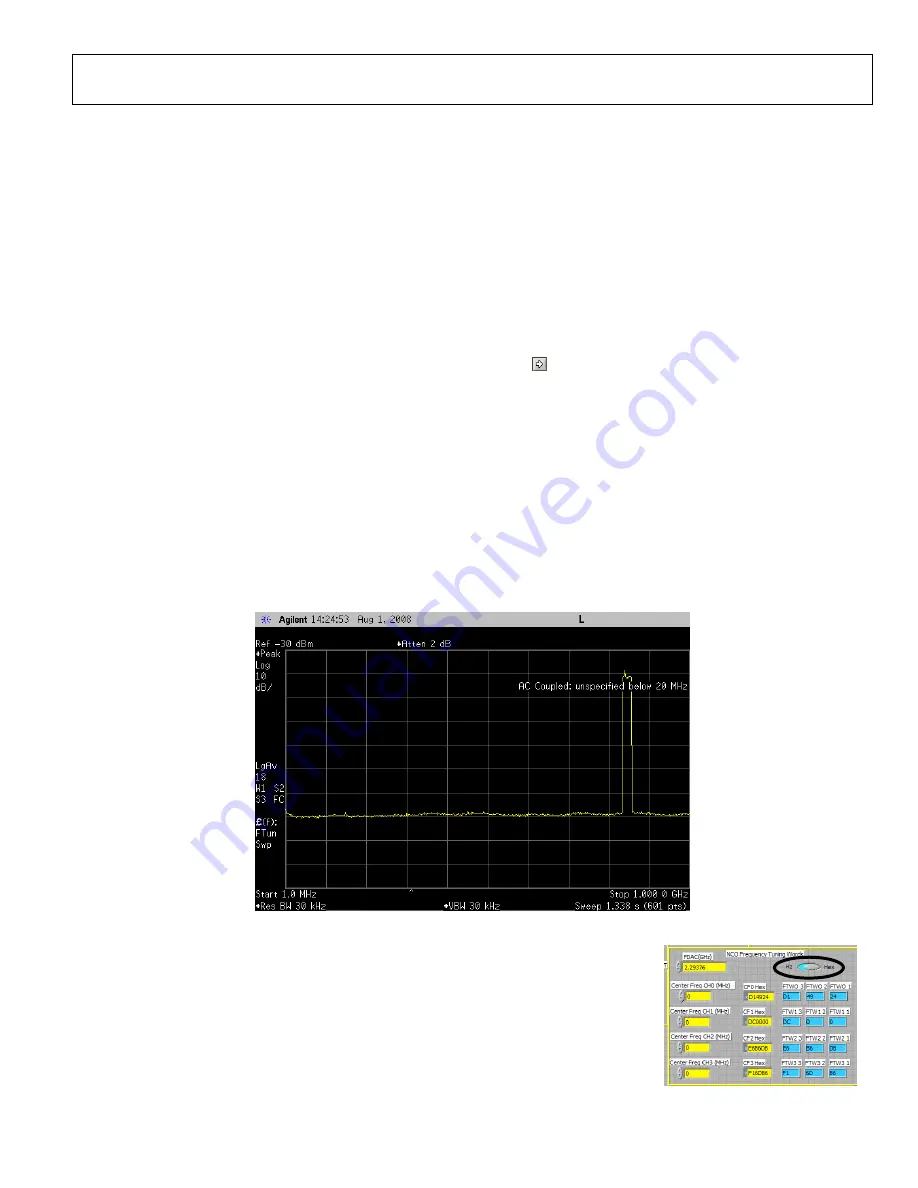
Quick Start Guide
AD9789-EBZ
Rev. A | Page 3 of 8
Figure 5
Internal QAM Test
In this example, the AD9789 is configured to generate a QAM vector internally by using the internal pseudo-random number (PRN)
generator in conjunction with the on-chip QAM encoder. This allows the user to measure the AC performance of a QAM signal at the
DAC output without needing an external data source. The steps that follow show the user how to enable the internal PRN generator and
setup each channel of the data path to map the PRN to 256QAM, shape and interpolate the QAM carrier such that it is DOCSIS
compliant and modulate each channel to 834MHz, 840MHz, 846MHz, and 852MHz respectively (Fdac=2.29376GHz).
Install the software as described in the
Software
section, and connect all the required cables as described in the
Hardware Setup
section.
Turn on the power supply. The current should be approximately 200mA. For this setup, the clock source should be set to generate a
2.29376GHz tone at 2dBm. Jumpers JP9 and JP10 should be set to their LVDS position (towards the DPG2 connector).
Open the AD9789 PRN software (Start > Programs > Analog Devices > AD9789-EBZ > AD9789 PRN). Click Run, and wait for the status
indicator to become bright green. Next, open the AD9789 SPI application (Start > Programs > Analog Devices > AD9789-EBZ > AD9789
SPI). Click the Load button, and then click the Run button ( ). When prompted for a file to load, select
AD9789_SPISettings_Int_QAM.txt
. Once that run has completed, click the Load button again to de-select it. Enable the PARMNEW
button, and click Run again. De-select PARMNEW after the run has completed.
Also, ensure that the FREQNEW control bit is set. This bit needs to be set for any changes made to the center frequency of the BPF and
the rate converter (P/Q) to take effect. If the FREQNEW is set properly, the read back indicators for the rate converter and BPF will be
updated to the correct values upon the second run of the SPI program. Note that FREQNEW is a self-clearing bit and can therefore
always be set high.
Expected DAC Performance
For the setup described in above the expected DAC output spectral performance is illustrated in Figure 4.
DAC Settings: f
DAC
= 2.29376GHz, f
C0
= 834MHz, f
C1
= 840MHz, f
C2
= 846MHz, f
C3
= 852MHz, f
BPF
= 843MHz, QAM Mapper, SRRC,
Filters1-4 enabled
Figure 4
The center frequencies, QAM Mapper modes, # of carriers, etc. can be varied for an assortment of
AC performance testing.
Take note of the Hz or Hex slide control in Figure 5. Once a SPI configuration file is loaded this
slide control will be set to Hex, meaning that center frequencies of the channels are controlled by
entering the Frequency Tuning Word (FTW) for each NCO. The user can opt to change this control
to Hz and control the center frequencies of the channels by inputting the desired frequency in MHz
and the software will calculate the FTW. Note that for this calculation to be accurate, the user must
also enter the DAC rate in GHz.








